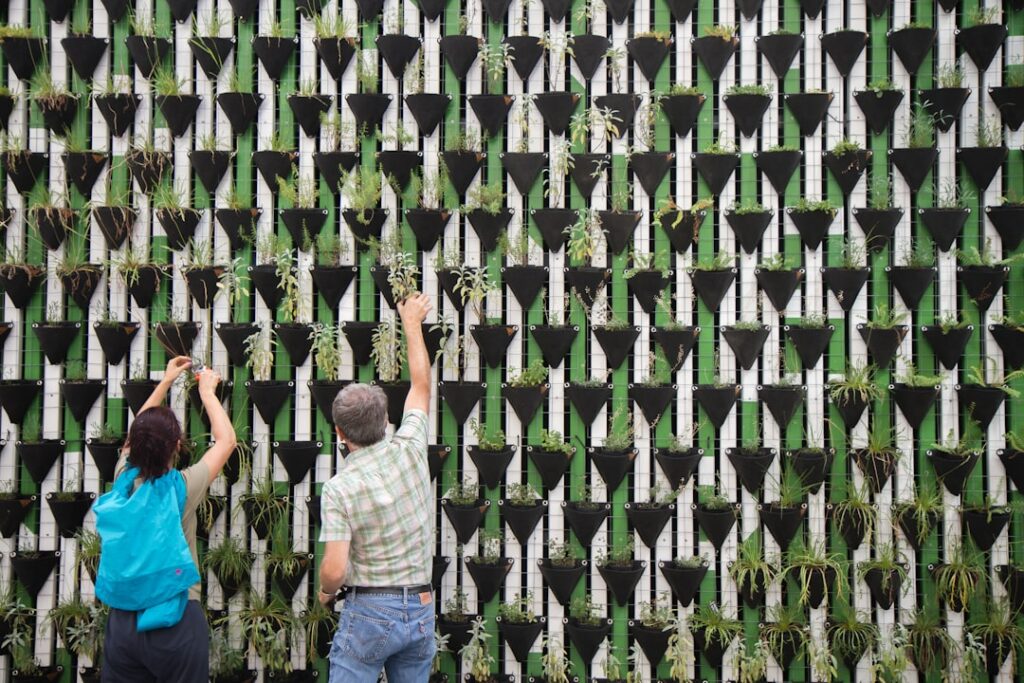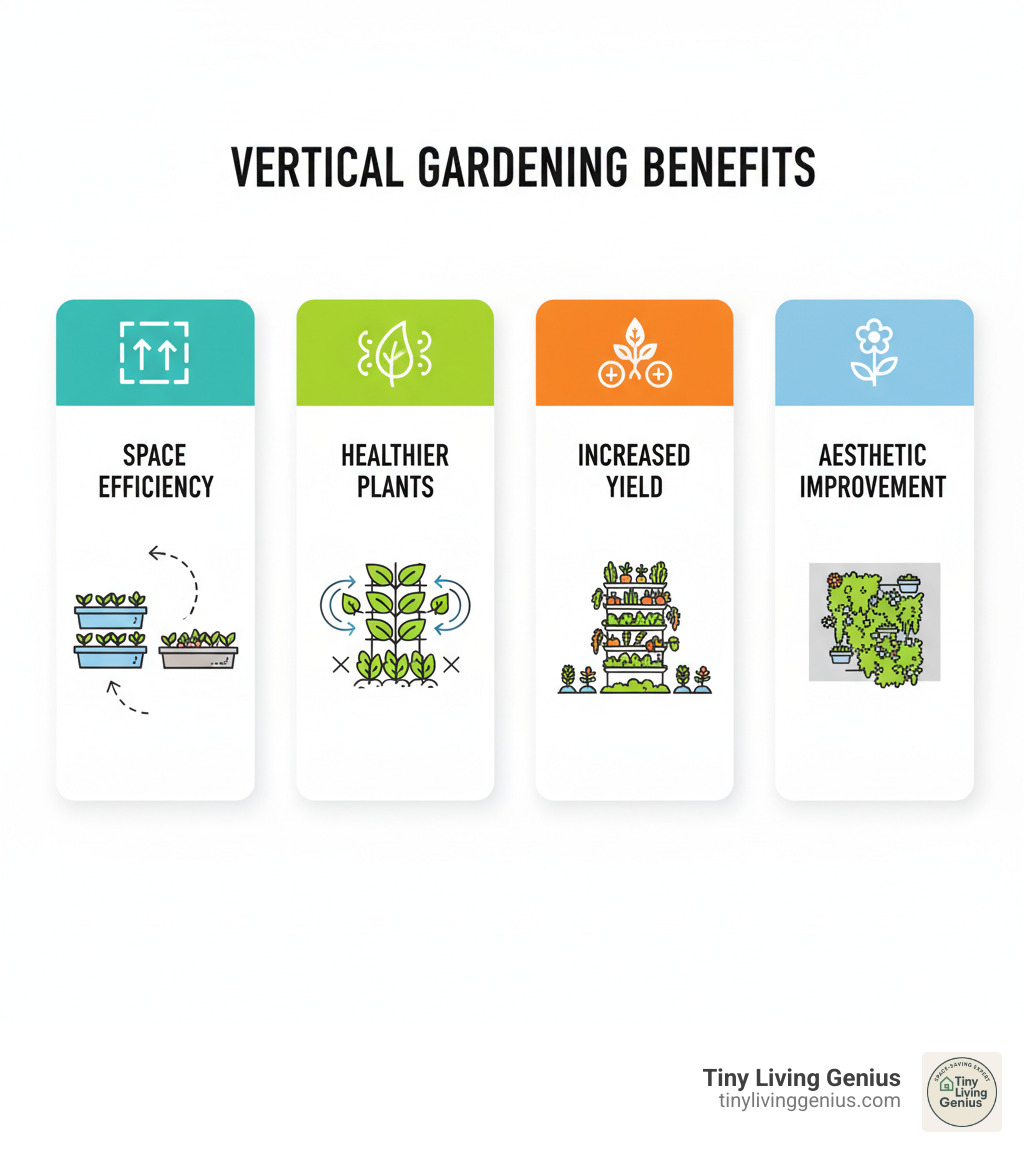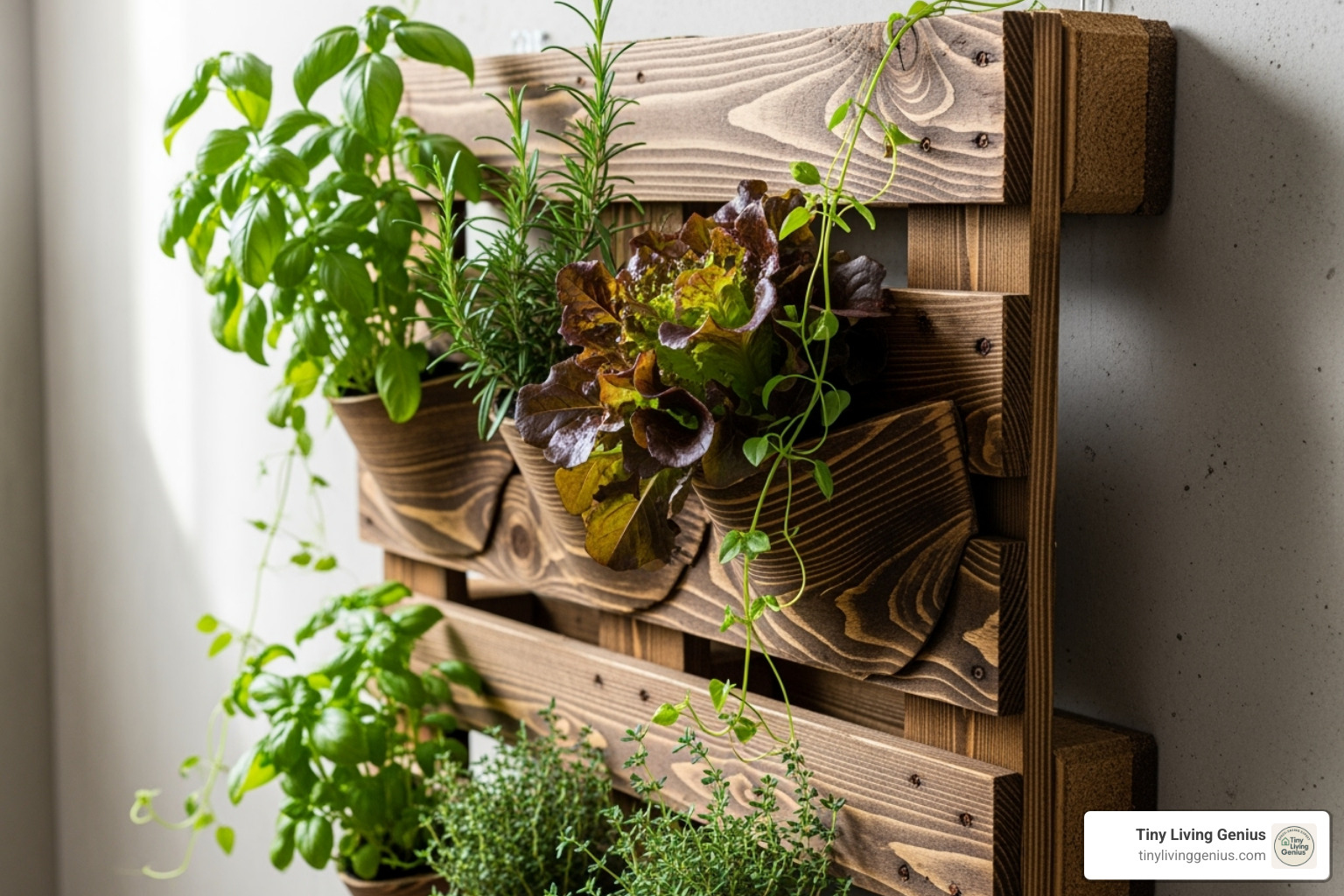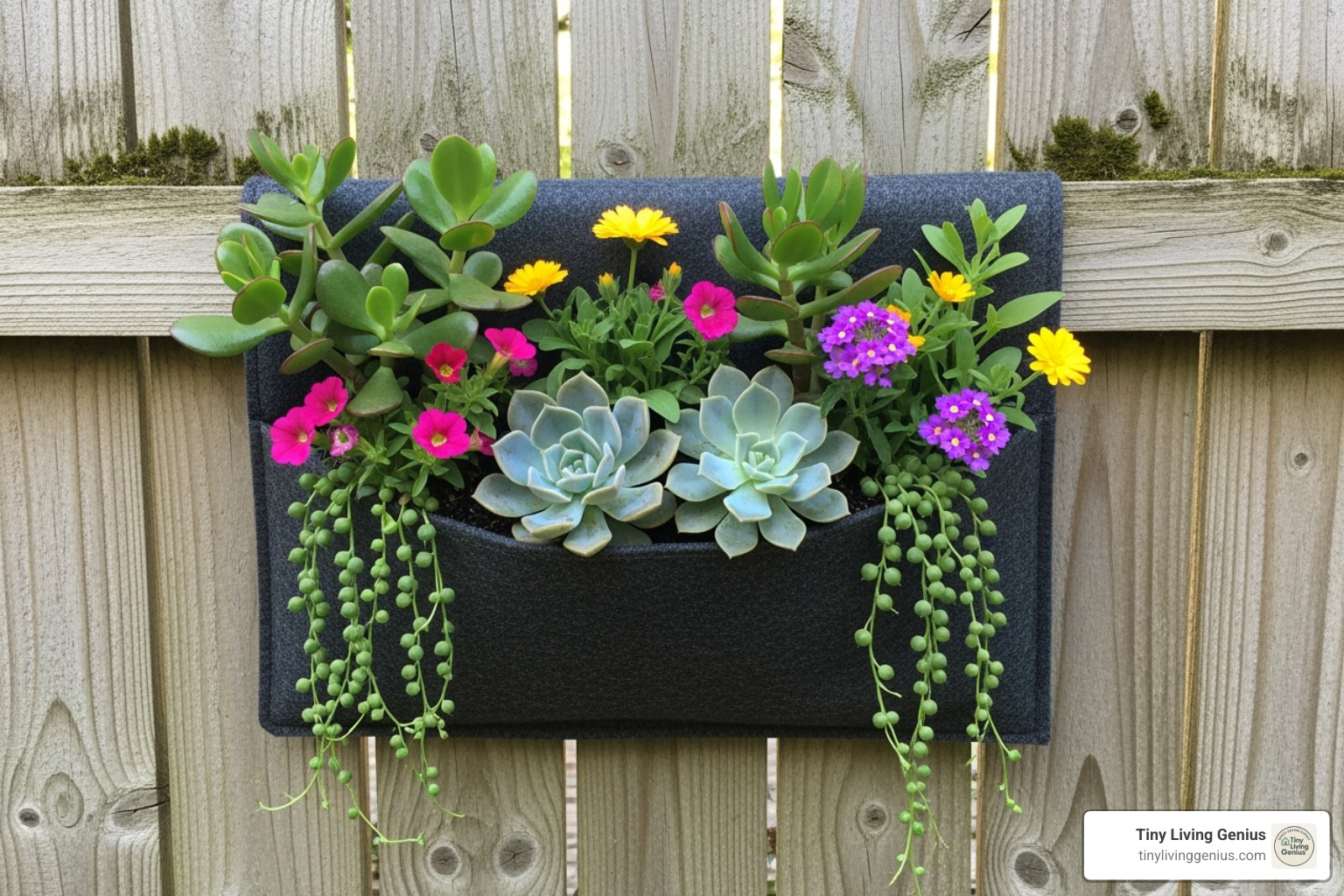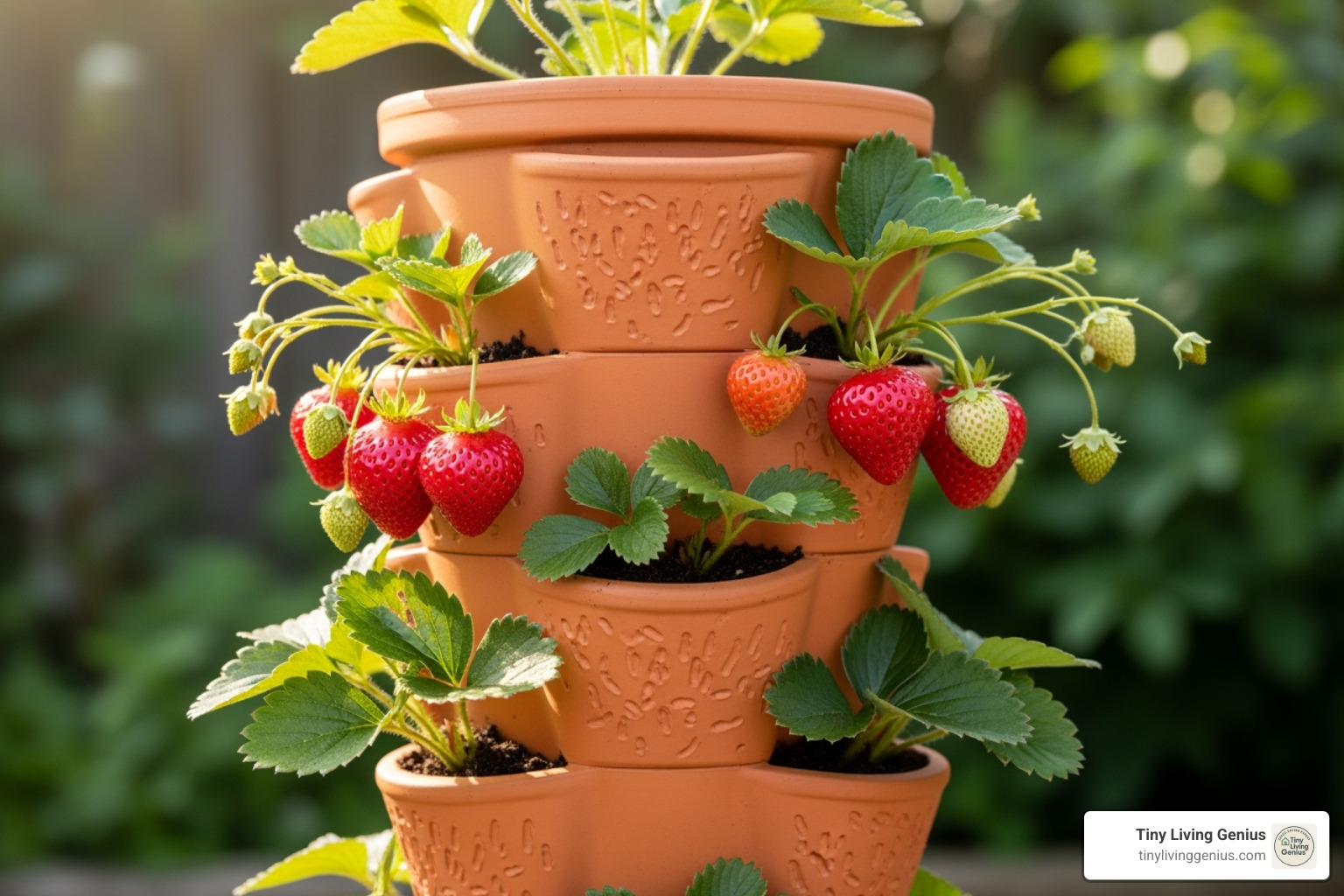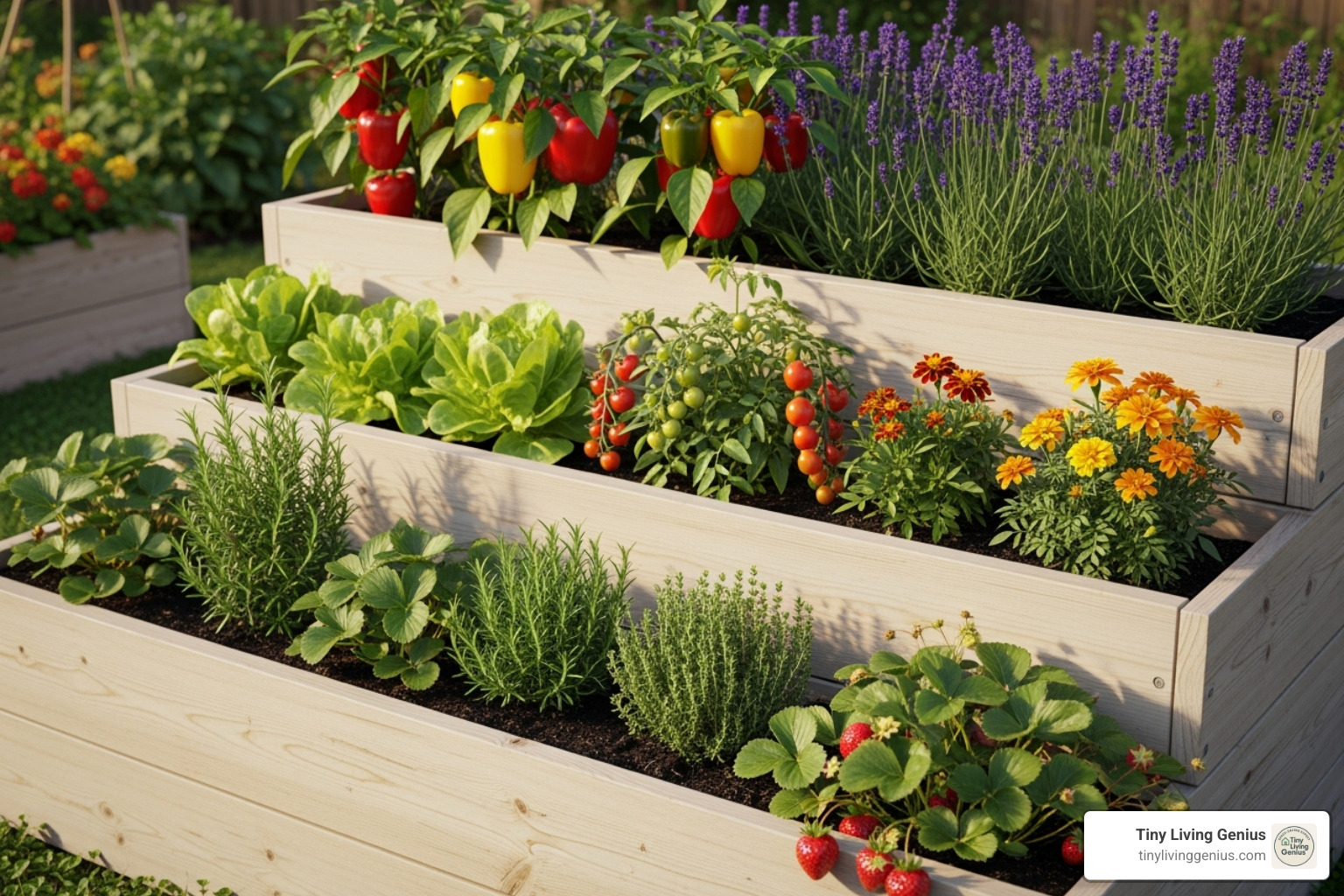Vertical gardening ideas for small spaces: 10 Amazing
Why Small Spaces Need Smart Growing Solutions
Vertical gardening ideas for small spaces transform cramped apartments and tiny balconies into thriving green oases. Whether you’re working with just a few square feet or struggling to find room for even a single planter, growing upward instead of outward open ups incredible possibilities.
Quick Vertical Gardening Solutions:
- Wall-mounted planters – Use fence space or apartment walls
- Stacked containers – Create tiers with ladders or shelving
- Hanging baskets – Maximize overhead space
- Trellis systems – Train vining plants upward
- Living walls – Transform blank surfaces into gardens
- Repurposed items – Turn pallets, gutters, or cans into planters
Living in a small space doesn’t mean giving up your gardening dreams. One famous example showed a gardener logging 180 pounds of fresh produce from a tiny balcony garden, including 63 pounds of tomatoes – all because they thought vertically instead of horizontally.
The beauty of vertical gardening lies in its efficiency. A squash plant that normally sprawls across 20 square feet can thrive in just a few square feet when grown up a trellis. Your plants get better air circulation, you deal with fewer pests, and harvesting becomes easier since everything’s at eye level.
I’m Ramy Saber, and through my work in facility operations and small-space optimization, I’ve finded that vertical gardening ideas for small spaces are often the missing piece in creating functional, beautiful living environments. My experience managing compact spaces has shown me how growing upward can transform both your food supply and your living experience.
Why Go Vertical? The Surprising Benefits of Upward Gardening
When you’re working with limited square footage, every inch counts. That’s where vertical gardening ideas for small spaces become absolute game-changers. Think of it as giving your garden a growth spurt – literally upward!
Space maximization is the most obvious benefit, but the results can be truly surprising. Take that sprawling squash plant that normally hogs 20 square feet of ground space. Train it up a simple trellis, and suddenly it only needs a few square feet at the base. You’ve just freed up precious real estate for more plants while getting the same delicious harvest.
This concept perfectly aligns with our philosophy at Tiny Living Genius – making every square inch work harder and smarter. You can find more strategies in our guide to maximize vertical space in small spaces.
But here’s where it gets really interesting: vertical gardening doesn’t just save space – it actually creates healthier plants. When your leafy greens and herbs are lifted off the ground, they enjoy better air circulation around their foliage. This natural airflow acts like a protective shield against fungal diseases and bacterial infections that love to attack plants sitting in damp, stagnant conditions.
Ground-dwelling pests also have a much harder time reaching your liftd crops. No more slugs munching through your lettuce or soil-borne diseases wreaking havoc on your tomatoes. The result? Reduced soil-borne diseases and fewer pests naturally, without chemicals.
Let’s talk about convenience – because who doesn’t love easier harvesting? Vertical gardens put your produce right at eye level or within easy reach. No more crawling around on your hands and knees or doing awkward yoga poses to reach that perfect tomato. Your back will thank you, and you’ll actually enjoy tending your garden more.
The aesthetic improvement potential is absolutely stunning. A well-designed vertical garden transforms any boring wall or fence into a living masterpiece. These living walls serve double duty as natural privacy screens while hiding unsightly views like that not-so-charming dumpster area or your neighbor’s cluttered balcony.
Here’s a fascinating fact: a living wall can cool a surface by up to 50°F. That’s serious natural air conditioning! Your apartment stays cooler in summer, your energy bills drop, and you’re doing something wonderful for the environment.
Speaking of environmental benefits, vertical gardens are urban biodiversity heroes. They create cooling walls that reduce the heat island effect in cities while providing habitat for beneficial insects and birds. Every vertical garden contributes to increased urban biodiversity, turning concrete jungles into more livable spaces.
Water conservation is another hidden gem of vertical gardening. When you water vertically, you’re directing moisture exactly where plants need it – at their roots. Less water evaporates into thin air, and there’s minimal runoff compared to traditional ground-level beds.
The beauty of vertical gardening lies in how it solves multiple problems at once. You get more growing space, healthier plants, easier maintenance, better aesthetics, and environmental benefits all rolled into one smart solution. It’s the perfect example of how thinking creatively about small spaces can yield surprisingly big results.
10 Creative Vertical Gardening Ideas for Small Spaces
Ready to transform your tiny space into a green paradise? I’m excited to share some of my favorite vertical gardening ideas for small spaces that’ll help you make the most of every wall, fence, and corner you have. These solutions range from simple weekend DIY projects to neat modular systems that look like they came straight from a design magazine.
1. The Repurposed Pallet Planter
Let’s start with one of the most beloved budget-friendly options – the pallet planter! There’s something deeply satisfying about taking a discarded wooden pallet and turning it into a thriving herb garden.
The beauty of this project lies in its simplicity. All you need is a wooden pallet (often free from local businesses), some landscape fabric, and a staple gun. Simply line the back and bottom of each pallet opening with the fabric to create individual planting pockets. Make sure to poke a few drainage holes in the fabric – your plants will thank you later!
This setup is perfect for shallow-rooted plants like basil, mint, parsley, lettuce, and spinach. You can lean it against a wall for a casual look or mount it securely for a more permanent installation. The rustic charm adds character to any small space, whether it’s a tiny balcony or a narrow side yard.
2. The Leaning Ladder Garden
There’s something wonderfully whimsical about an old stepladder given new life as a garden display. This is one of those vertical gardening ideas for small spaces that combines functionality with vintage charm.
You can use the ladder’s natural rungs as shelves for potted plants, or get creative with S-hooks and metal containers for a more integrated look. Just remember to drill drainage holes in any containers that don’t already have them – waterlogged roots are never happy!
The ladder garden works beautifully on porches and patios, creating a multi-level display that draws the eye upward without hogging precious floor space. You can find many step-by-step instructions online for creating your own ladder garden. This clever approach perfectly aligns with our philosophy of Smart Storage Solutions for Small Spaces.
3. Wall-Mounted Pocket Planters
If you want instant gratification, fabric pocket planters are your new best friend. These modular systems consist of multiple pockets sewn into durable felt or fabric, designed to hang directly on walls or fences.
Installation couldn’t be easier – just hang them up and start planting! The soft fabric material provides excellent aeration and drainage, while the modular design lets you create a living wall of any size. They’re absolutely perfect for succulents, herbs, and small annual flowers that don’t need deep root space.
These pocket planters transform blank walls into instant green focal points. You can find quality options like this vertical pocket planter to get your living wall started right away.
4. Gutter Gardens
Before you toss those old rain gutters, consider giving them a second life as unique planters! This creative approach involves mounting gutters horizontally in tiers on walls or fences.
The process is straightforward: cut gutters to your desired length, attach end caps, and drill drainage holes along the bottom. Mount them using sturdy brackets, and you’ve got yourself a sleek, modern planting system.
Gutter gardens excel with shallow-rooted plants like lettuce, spinach, radishes, and herbs. They’re also fantastic for strawberries – the berries hang freely, staying clean and making harvesting a breeze. Plus, the linear design creates clean, contemporary lines that work especially well in modern small spaces.
5. Hanging Baskets and Colanders
Sometimes the simplest solutions are the most effective. Hanging baskets have been a small-space gardening staple for good reason – they use that often-forgotten overhead space from porch ceilings, pergolas, or shepherd’s hooks.
For a fun twist, try making DIY planters from old metal colanders. Those built-in drainage holes are perfect for plants! Just line them with landscape fabric or coconut coir, fill with quality potting soil, and plant away.
Colander planters add a delightful whimsical touch and work wonderfully for trailing flowers like petunias or edibles like strawberries. This creative repurposing is just one example of the many Creative Ideas for Small Space Furniture: Maximizing Functionality we love exploring.
6. Trellis and Wall Grids
When people think of vertical gardening ideas for small spaces, trellises often come to mind first – and there’s a good reason for that popularity! These versatile structures are champions at training vining plants upward.
Your options are endless: decorative arches, neat obelisks, or simple grid systems. Attach them to existing walls and fences, or set them up as freestanding features. They’re ideal for vining vegetables like cucumbers (this cucumber trellis is particularly well-designed), pole beans, and sweet peas.
For privacy and beauty combined, train climbing roses, clematis, or morning glories up your trellis. You’ll create a stunning living screen that blocks unsightly views while adding natural beauty to your space.
7. Stacked Planters and Towers
Stacked planters, often called strawberry towers, are ingenious space-savers that let you grow multiple plants in a tiny footprint. These vertical systems feature several planting pockets or tiers stacked on top of each other.
You can buy beautiful commercial versions made from terracotta or plastic, or get crafty and build your own using stacked buckets or large PVC pipes with holes cut out. They’re fantastic for high-yield crops like strawberries, herbs, and leafy greens.
The vertical design maximizes your harvest while minimizing your footprint – perfect for balconies and patios where every square inch counts. A quick search for DIY strawberry tower projects will give you plenty of inspiration.
8. The Living Wall Frame
Transform your plants into living artwork with a wall-mounted frame garden. This approach is particularly stunning with succulents, creating a low-maintenance, drought-tolerant masterpiece.
The concept involves using a shadow box frame lined with chicken wire and filled with specialized cactus potting mix. Succulents are carefully placed through the wire openings, creating a dense, beautiful mosaic that serves as both garden and art.
This living art piece works beautifully indoors or outdoors, making a bold statement on any bare wall. You can find excellent step-by-step tutorials online that provide detailed guidance on creating your own succulent frame.
9. Upcycled Tin Can Fence Garden
For the ultimate budget-friendly project with maximum charm, gather up some old tin cans! This delightful DIY involves changing discarded cans into colorful individual planters.
Paint them in vibrant colors or leave them rustic – whatever matches your style. Drill drainage holes in the bottom, then attach them to fences or walls using screws or strong wire. Each can becomes a perfect home for individual herbs, small flowers, or microgreens.
This project adds a personalized, whimsical touch to any garden while giving new life to items that would otherwise end up in the trash. It’s especially fun to do with kids, who love the creative painting process!
10. The Tiered Raised Bed
While “raised bed” might sound horizontal, a tiered version takes brilliant advantage of vertical space by stacking multiple growing levels. This clever design can provide an extra 40 square feet of garden space in the same footprint as a traditional bed!
The different levels create natural microclimates within a single structure – you can place sun-loving plants on the top tier while shade-tolerant varieties thrive on the lower levels. This means you can grow a much wider variety of plants in one compact system.
This approach represents the kind of Efficient Design for Small Spaces: Stylish Living Solutions we’re passionate about. Detailed plans and inspiration for tiered beds can be found with a bit of online searching, showcasing unique solutions for gaining extra garden space.
The Perfect Plants & Care for Your Vertical Oasis
Choosing the right plants for your vertical gardening ideas for small spaces is like picking the perfect roommates – you want companions that thrive together and make the most of your shared space. The beauty of vertical gardening lies in matching plants to their ideal growing conditions while maximizing every precious inch.
Best Plants for Vertical Gardening Ideas for Small Spaces
As one famous case showed, harvesting over 180 pounds of fresh produce from a tiny balcony is possible, proving that vining vegetables are the true champions of vertical growing. Cucumbers absolutely love climbing trellises, changing from space-hogging ground sprawlers into productive vertical performers. Pole beans and peas are natural climbers that fix nitrogen in the soil while producing abundant harvests. Even small melons and vining tomatoes can work magic when trained upward – that squash plant that normally demands 20 square feet on the ground suddenly needs just a few square feet when it grows up instead of out.
Leafy greens and herbs are perfect partners for shallow-rooted vertical systems like pocket planters and gutter gardens. Lettuce, spinach, and kale provide continuous harvests while taking up minimal root space. Fresh herbs like basil, mint, parsley, and chives thrive in vertical setups, giving you instant access to flavor improvers right outside your kitchen window.
For those sweet rewards, strawberries are practically made for vertical gardening. They cascade beautifully from hanging baskets and stacked planters, keeping the berries clean and easy to harvest. Alpine strawberries are especially perfect for small spaces, producing tiny but flavorful fruits all season long.
Don’t forget the beauty factor! Trailing flowers and ornamentals turn functional gardens into stunning displays. Supertunia® petunias create cascading waterfalls of color, while succulents and ferns add texture and year-round interest with minimal fuss.
Essential Care: Soil, Water, and Maintenance
Here’s where vertical gardening gets a bit different from traditional ground-level growing. Container soil dries out faster than garden beds, so we need to be more attentive to our plants’ needs.
Start with high-quality potting mix – this isn’t the place to cut corners. Garden soil gets too heavy and compacted in containers, but good potting mix provides the perfect balance of drainage and moisture retention. Always ensure good drainage by checking that your containers have adequate holes. Waterlogged roots are unhappy roots!
Watering frequency becomes your daily ritual. Check soil moisture daily by sticking your finger an inch or two into the soil. If it feels dry, it’s time to water. During hot summer days, you might find yourself watering twice daily, especially for hanging baskets that catch more wind and sun.
For busy gardeners or vacation peace of mind, drip irrigation systems are game-changers. The WaterWise® drip irrigation system can automate your watering schedule, delivering just the right amount of moisture to each plant’s roots.
Fertilizing needs are higher in containers since frequent watering washes nutrients away. Start strong by mixing slow-release fertilizer into your potting mix at planting time. Throughout the growing season, supplement with liquid feed every few weeks to keep your plants happy and productive.
Pruning and training vines becomes an enjoyable weekly task. Gently guide new growth onto supports, tying stems loosely to allow for expansion. This directs the plant’s energy efficiently while keeping your vertical garden looking tidy and productive.
The reward for this extra attention? Healthier plants, better harvests, and a stunning living display that proves small spaces can produce big results. Your vertical oasis will become a source of daily joy and fresh flavors that make every bit of care worthwhile.
Frequently Asked Questions about Vertical Gardening
Starting your vertical gardening ideas for small spaces journey can feel overwhelming, especially when you’re trying to figure out the basics. Don’t worry – we’ve all been there! Here are the most common questions we get about vertical gardening, along with practical answers that’ll help you grow with confidence.
How much sun does a vertical garden need?
The sun requirements for your vertical garden depend entirely on what you want to grow. Think of it as matching plants to your space’s personality!
Most vegetables and flowering plants are sun lovers, craving at least 6 hours of direct sunlight daily to produce their best harvest. Tomatoes, peppers, cucumbers, and most fruits fall into this category. They need that full sun to develop sugars, produce abundant flowers, and create the yields we’re hoping for.
But here’s the good news – if your balcony or patio gets less sun, you’re not out of luck! Leafy greens and many herbs are much more forgiving, thriving with just 3 to 5 hours of direct sun or even bright indirect light. Lettuce, spinach, kale, mint, parsley, and chives actually appreciate some relief from intense afternoon sun.
Even shadier spots with just 2 to 4 hours of sun can support certain leafy crops, herbs like cilantro or mint, and even some fruits like rhubarb or woodland berries. For truly shady areas, consider mints, Thai basil, watercress, sorrel, lemon balm, and violets.
The secret is observing your space throughout the day. Notice where the sun hits and for how long, then choose plants that match those conditions rather than fighting against them.
How do you water a vertical garden without making a mess?
Ah, the age-old question that every vertical gardener faces! Nobody wants muddy water dripping onto their balcony or indoor floors. The good news is that with a few smart techniques, you can keep things tidy.
Water slowly and directly at the base – this is your golden rule. Skip the overhead sprinkler approach that splashes soil everywhere. Instead, use a watering can with a long, narrow spout to direct water precisely where each plant needs it.
Consider self-watering planters for convenience. Many commercial vertical systems include built-in reservoirs that minimize runoff and keep watering mess-free.
For larger setups, drip irrigation systems are absolute game-changers. These deliver water directly to each plant’s root zone with surgical precision. A WaterWise® drip irrigation system on a timer can automate the whole process, making your life much easier.
Here’s a clever trick: ice cubes work wonderfully for smaller containers, especially ones that have dried out completely. As they melt slowly, they provide controlled hydration without overflow.
For indoor setups or anywhere runoff is a concern, always place collection trays at the bottom of your vertical system. This catches excess water and protects your floors while preventing waste.
Are vertical gardens expensive to set up?
This is probably our favorite question because the answer is so encouraging – vertical gardens can fit virtually any budget!
Budget-friendly DIY options are where most people start, and honestly, they’re often the most rewarding. Repurposed materials like wooden pallets, old ladders, tin cans, or rain gutters can create stunning vertical gardens for very little money. A roll of welded wire might cost around $35, and T-posts about $4 each – enough to build sturdy trellises that would cost much more store-bought.
Mid-range options include modular fabric pocket planters, basic tiered systems, or simple pre-made trellises. These offer convenience without breaking the bank. You might spend around $35 for a good trellis that’ll support a cucumber plant for years.
High-end commercial systems with integrated irrigation and specialized growing mediums do exist, but they’re definitely not necessary for success. These are typically for people wanting a very polished, professional look.
Our philosophy at Tiny Living Genius is always to start small and build up. Begin with one or two budget-friendly projects to learn what works in your specific space and climate. As your confidence grows and you see what thrives, you can gradually invest in more elaborate systems.
The beauty of vertical gardening is that some of the most productive and beautiful gardens we’ve seen started with nothing more than creativity and a few repurposed containers. Your green thumb matters far more than your budget!
Conclusion: Grow Big in Your Small Space
Your journey into vertical gardening ideas for small spaces doesn’t have to end here. What started as a simple desire to add some greenery to your tiny balcony or cramped patio can blossom into something truly transformative.
Think about it: we’ve finded how a single squash plant can shrink from hogging 20 square feet to just a few when grown vertically. We’ve seen how one gardener harvested 180 pounds of fresh produce from a small balcony, including 63 pounds of tomatoes, simply by thinking upward instead of outward. These aren’t just gardening tricks – they’re space-maximizing solutions that can completely change how you experience your home.
The beauty of vertical gardening lies in its accessibility. Whether you’re working with a repurposed pallet filled with fresh herbs, a charming ladder garden on your porch, or an neat living wall frame showcasing colorful succulents, each project proves that creativity trumps square footage every time.
At Tiny Living Genius, we’ve seen countless small spaces transformed through smart vertical solutions. Your walls, fences, and even ceiling space are all untapped opportunities waiting to become productive, beautiful gardens. Every blank surface holds the potential to become a thriving green oasis that not only feeds your body but nourishes your soul.
The environmental benefits make this journey even more meaningful. When you create a living wall that cools surfaces by up to 50°F, improve air quality, and provide habitat for beneficial insects, you’re contributing to something bigger than just your own harvest. You’re helping create more sustainable, livable urban spaces.
Don’t let limited ground space crush your gardening dreams. Start small with a few hanging baskets or a simple trellis system. Experiment with gutter gardens for your herbs or try your hand at a stacked planter tower for strawberries. Each success will build your confidence and inspire your next vertical adventure.
Gardening is possible for everyone – even in the tiniest spaces. Your balcony, patio, or even a sunny window can become a productive paradise when you accept the vertical frontier. Explore more ways to Maximize Vertical Space in Small Spaces and find how every inch of your home can work harder and smarter for you.

